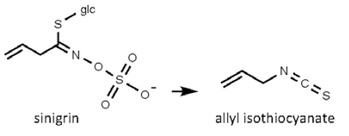 Armoracia rusticana
Armoracia rusticana
horseradish
Back to “Spices: horseradish (Armoracia rusticana)r”
Armoracia rusticana P.Gaertn., Mey. & Scherb. (Brassicaceae); peperwortel (Afrikaans); la gen (Chinese); křen (Czech); piparjuuri (Finnish); raifort, grand raifort (French); Meerrettich, Kren (German); torma (Hungarian); cren (Italian); hoosuradiishu, seiyou wasabi (Japanese); chrzan (Polish); khren (Russian); rábano picante (Spanish); pepparot (Swedish)
DESCRIPTION The thick fleshy roots are yellowish brown in colour with white flesh. Intact roots have no odour, but a hot, biting, pungent taste and a sharp smell develop when they are grated, crushed or powdered.1
THE PLANT A perennial leafy herb of up to 1.2 m (4 ft) in height. It bears large, soft, bright green leaves, small white flowers and oblong seed capsules. The fruits only rarely form viable seeds.1
ORIGIN Probably southeastern Europe and western Asia.2,3 It appears to be a sterile cultigen, of hybrid origin, that has been cultivated only for the last 2 000 years.2,3 The plant has been particularly popular in central Europe (sometimes called “German mustard”) but is now grown commercially in many parts of the world. It has become invasive in parts of the United States.1
CULTIVATION Propagation is from root crowns or root cuttings. It prefers deep, moist, rich loam soil and grows best is semi-shaded places. Horseradish is a perennial crop in Europe but is grown as an annual in the United States.1
HARVESTING Roots are dug up in autumn and the lateral roots removed and stored in a dark place for planting in the following season. At the factory, the roots are cleaned, trimmed, grated and processed. Larger roots are preferred as they allow easier and more efficient processing.
CULINARY USES Horseradish sauce is made by mixing grated root with vinegar and salt and blending it with milk or cream into a ready-to-use cream sauce. The root can be dried and powdered or mixed with mustard (Creole mustard), vinegar (horseradish vinegar), mayonnaise or red beet juice (red horseradish).4 Famous variations include the English “Tewkesbury mustard” (mentioned by Shakespeare), Austrian Krensenf, German Tafelmeerrettich and American “horseradish sauce”. The sauce is used sparingly as a condiment, commonly with meat and fish dishes. It is particularly popular in the Alsace, Germany, eastern Europe, Russia and Scandinavia but has also become a favourite in the United States as an ingredient of hot and cold sauces, including mustards, dips, relishes and salad dressings. It is an ideal condiment for beef, pork, sausages and potato salad. Scandinavian dishes such as herring, smoked reindeer and smoked trout are traditionally served with horseradish sauce. Horseradish loses its pungency when it is exposed to the heat of cooking. It is therefore best used fresh or added to a warm dish just before serving.
FLAVOUR COMPOUNDS The pungent aroma is due to mustard oils (glucosinolates). When horseradish roots are damaged by grating or grinding, the glucosinolate (sinigrin) that is stored in the vacuoles of the root cells comes into contact with enzymes (thioglucosidase or myrosinase). The sinigrin is hydrolysed and further chemically modified to produce the highly reactive and pungent allyl isothiocyanate.1

NOTES Horseradish can be dangerous when taken in large quantities. The mustard oils may irritate the lining of the mouth, throat, nose, digestive system and urinary tract.
1. Farrel, K.T. 1999. Spices, condiments and seasonings. Aspen Publishers, Gaithersburg, USA.
2. Courter, J.W., Rhodes, A.M. 1969. Historical notes on horseradish. Economic Botany 23: 156–164.
3. Wedelsbäck Bladha, K., Olsson, K.M. 2011. Introduction and use of horseradish (Armoracia rusticana) as food and medicine from antiquity to the present: emphasis on the Nordic countries. Journal of Herbs, Spices & Medicinal Plants 17: 197–213.
4. Kiple, K.F., Ornelas, K.C. (Eds) 2000. The Cambridge world history of food. Cambridge University Press, Cambridge.